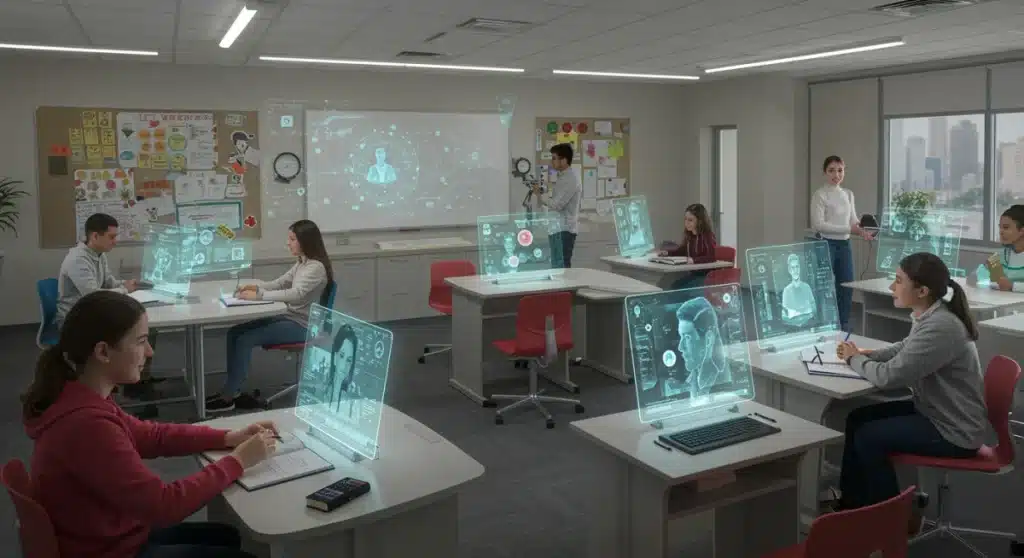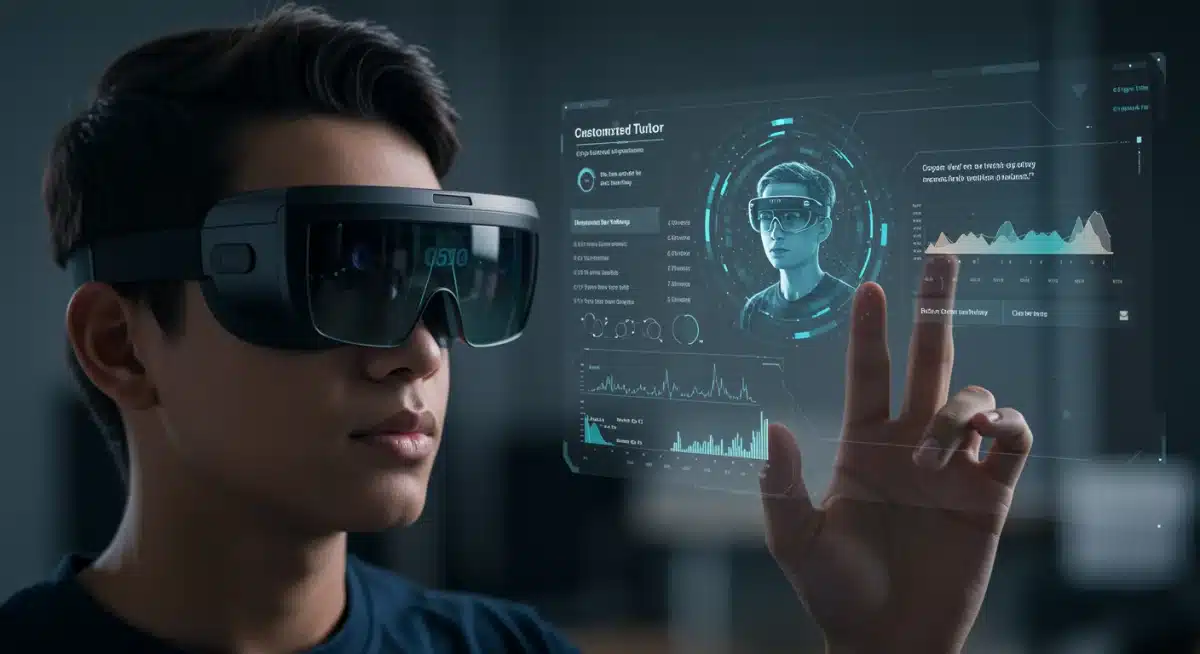Personalized Learning AI: Transforming US Classrooms by 2029

Personalized learning AI is poised to revolutionize US classrooms by 2029, enhancing student outcomes by an estimated 20% through adaptive curricula, intelligent tutoring systems, and data-driven insights tailored to individual student needs.
The landscape of education in the United States is on the cusp of a profound transformation. By 2029, experts project that personalized learning AI will fundamentally reshape US classrooms, leading to a significant 20% improvement in student outcomes. This shift is driven by rapidly advancing artificial intelligence technologies designed to adapt educational content and methodologies to each student’s unique needs, pacing, and learning style.
The Dawn of Adaptive Learning Systems in US Education
Adaptive learning systems, powered by artificial intelligence, are no longer a distant concept but a rapidly unfolding reality in US education. These systems leverage sophisticated algorithms to analyze student performance, identify knowledge gaps, and then dynamically adjust the learning path and content difficulty. This ensures that each student receives instruction precisely tailored to their current understanding and progress.
As of late 2023 and early 2024, pilot programs across various states are demonstrating the efficacy of these personalized approaches. Early data indicates higher engagement levels and improved mastery of complex subjects. The promise of a 20% improvement in outcomes by 2029 hinges on the widespread adoption and refinement of these technologies, moving beyond one-size-fits-all instruction.
AI’s Role in Individualized Education Plans
Artificial intelligence is becoming instrumental in creating and refining individualized education plans (IEPs) for all students, not just those with special needs. AI platforms can ingest vast amounts of data—from classroom performance to extracurricular activities—to build comprehensive student profiles. This data then informs the AI’s recommendations for learning modules, interventions, and enrichment activities.
- Diagnostic Precision: AI quickly identifies specific areas where students struggle or excel.
- Content Curation: Personalized content from diverse sources is recommended based on learning styles.
- Progress Tracking: Real-time monitoring allows for immediate adjustments to learning paths.
- Teacher Support: AI tools provide teachers with actionable insights to guide their instruction.
Intelligent Tutoring Systems: A New Era of Support
Intelligent tutoring systems (ITS) represent a significant leap forward in personalized learning AI. Unlike traditional educational software, ITS can simulate one-on-one human tutoring, offering immediate feedback, answering questions, and explaining concepts in multiple ways until a student grasps the material. These systems are designed to be patient, persistent, and infinitely adaptable to the learner.
Recent advancements in natural language processing (NLP) and machine learning have made ITS more sophisticated than ever. They can understand complex student queries, provide nuanced explanations, and even engage in Socratic dialogue to foster deeper critical thinking. This direct, personalized support is a cornerstone of the projected 20% improvement in student outcomes by the end of the decade.
Overcoming Learning Plateaus with AI
One of the persistent challenges in education is helping students overcome learning plateaus. Traditional methods often rely on repetitive exercises that can lead to disengagement. Personalized learning AI, particularly through ITS, addresses this by identifying the root cause of a plateau and offering targeted, varied approaches.
For example, if a student struggles with algebraic equations, the AI might present the concept visually, then through a game, and finally with an interactive problem-solving session, constantly assessing and adapting until mastery is achieved. This dynamic intervention prevents frustration and keeps students moving forward, contributing significantly to improved academic performance.
Data-Driven Insights: Empowering Educators and Students
The power of personalized learning AI extends beyond direct student interaction; it also provides unprecedented data-driven insights for educators, parents, and even students themselves. AI platforms collect and analyze vast amounts of performance data, identifying trends, predicting potential difficulties, and highlighting areas of strength. This wealth of information transforms teaching from guesswork to a highly informed, strategic process.
Teachers can now access dashboards that show real-time progress for each student, allowing them to intervene proactively or provide differentiated instruction. Students, in turn, gain a clearer understanding of their own learning journey, fostering greater autonomy and self-directed learning. This transparency and actionable data are crucial for achieving the ambitious goal of a 20% outcome improvement.

Predictive Analytics for Early Intervention
One of the most impactful applications of data-driven AI in education is predictive analytics. By analyzing historical data and current performance, AI can identify students who are at risk of falling behind long before they actually do. This early warning system allows educators to implement interventions proactively, preventing academic struggles from escalating.
- Risk Identification: AI flags students showing early signs of academic difficulty.
- Intervention Strategies: Recommends specific support or resources based on identified risks.
- Resource Allocation: Helps schools allocate tutoring or counseling resources more effectively.
- Personalized Feedback: Provides tailored feedback to students to encourage self-correction.
Curriculum Personalization and Content Delivery
Personalized learning AI is revolutionizing how curricula are designed and delivered. Instead of a static curriculum, AI enables a dynamic, responsive learning environment where content is continuously updated and adapted. This means textbooks can become interactive, lessons can incorporate real-world examples relevant to individual student interests, and assignments can reflect diverse learning preferences.
The ability to tailor content delivery, whether through visual aids, auditory explanations, or hands-on simulations, ensures that every student can access and engage with the material in a way that resonates with them. This level of customization was previously unimaginable but is now becoming standard, driving higher comprehension and retention rates across US classrooms.
Engaging Diverse Learners with AI-Driven Content
US classrooms are increasingly diverse, with students bringing a wide range of backgrounds, languages, and learning needs. AI-driven content personalization is uniquely positioned to address this diversity, creating inclusive learning experiences that cater to everyone. AI can translate content, provide cultural context, and offer alternative explanations, breaking down traditional barriers to learning.
This adaptability fosters a more equitable educational environment where every student feels seen and supported. The resulting increase in engagement and understanding is a key factor in the projected 20% improvement in educational outcomes, ensuring that no student is left behind due to a lack of appropriate resources or teaching methods.
Challenges and Ethical Considerations in AI Adoption
While the benefits of personalized learning AI are substantial, its widespread adoption also presents significant challenges and ethical considerations that must be addressed. Concerns include data privacy, algorithmic bias, and the potential for over-reliance on technology. Safeguarding student information and ensuring equitable access to these advanced tools are paramount as deployment accelerates.
Developers and educators are actively working to mitigate these risks. Robust data encryption protocols, transparent algorithmic design, and ongoing training for teachers are essential. The goal is to harness AI’s power responsibly, ensuring it serves as a tool to enhance human teaching and learning, not replace it, while upholding ethical standards and protecting student well-being.
Ensuring Equity and Accessibility for All Students
A critical challenge for personalized learning AI is ensuring that it does not exacerbate existing educational inequalities. Access to technology, reliable internet, and the necessary digital literacy skills vary widely across different socioeconomic groups. Developers and policymakers must collaborate to implement strategies that guarantee equitable access to AI-powered learning tools for all students, regardless of their background.
- Digital Divide: Addressing disparities in access to devices and internet connectivity.
- Teacher Training: Equipping educators with the skills to effectively integrate AI into their pedagogy.
- Algorithmic Bias: Developing AI that is fair and representative, avoiding perpetuation of stereotypes.
- Data Privacy: Implementing stringent policies to protect student data and ensure confidentiality.
The Future Classroom: Teachers as Facilitators, AI as Assistants
By 2029, the role of the teacher in US classrooms will evolve significantly. With personalized learning AI handling much of the individualized instruction and data analysis, teachers will transition from primary content deliverers to expert facilitators, mentors, and strategists. They will focus on higher-order thinking skills, collaborative projects, and socio-emotional development, areas where human interaction remains irreplaceable.
AI will serve as an invaluable assistant, freeing up teachers’ time from administrative tasks and repetitive grading, allowing them to dedicate more energy to creative teaching and personalized student engagement. This symbiotic relationship between human educators and artificial intelligence is the cornerstone of the projected 20% improvement in student outcomes, creating a more dynamic and effective learning environment for everyone.
Redefining Teacher Roles and Professional Development
The shift towards AI-assisted classrooms necessitates a redefinition of teacher roles and a significant investment in professional development. Educators will need training not only in operating AI platforms but also in interpreting AI-generated data, designing AI-enhanced lessons, and leveraging technology to foster deeper student engagement and critical thinking. This ongoing support is vital for successful integration.
The future classroom envisions teachers as orchestrators of rich learning experiences, supported by intelligent systems that manage the complexities of individual student paths. This evolution promises to elevate the teaching profession, making it more impactful and rewarding, and ultimately contributing to a more effective and equitable educational system across the United States.
| Key Point | Brief Description |
|---|---|
| Adaptive Learning | AI systems adjust content and pace to individual student needs, boosting engagement. |
| Intelligent Tutoring | AI provides one-on-one, real-time feedback and explanations, like a human tutor. |
| Data-Driven Insights | AI analyzes student data to inform educators and personalize learning paths effectively. |
| Teacher’s Evolving Role | Teachers become facilitators, utilizing AI as an assistant to enhance instruction. |
Frequently Asked Questions About Personalized Learning AI
Personalized learning AI refers to artificial intelligence systems that adapt educational content, pace, and methods to individual student needs. It works by analyzing student data, identifying learning patterns, and then delivering customized instruction and feedback in real-time, optimizing the learning experience for each student.
The projected 20% improvement stems from AI’s ability to provide highly targeted instruction, immediate feedback, and adaptive content. This reduces learning gaps, increases engagement, and ensures students master concepts more effectively than with traditional, one-size-fits-all teaching methods, leading to higher academic achievement.
Key challenges include ensuring data privacy and security, addressing potential algorithmic biases, bridging the digital divide for equitable access, and providing adequate training for educators. Overcoming these requires careful planning, ethical development, and robust infrastructure to support widespread adoption.
No, personalized learning AI is expected to augment, not replace, human teachers. AI will handle repetitive tasks and individualized instruction, freeing teachers to focus on complex problem-solving, social-emotional development, and fostering critical thinking skills, enhancing their role as facilitators and mentors.
Widespread adoption is anticipated progressively, with significant integration by 2029, as indicated by current trends and projections. Pilot programs are already underway, and continued advancements in AI technology, coupled with educational policy support, will drive its broader implementation across US classrooms in the coming years.
Looking Ahead
The rapid integration of personalized learning AI into US classrooms by 2029 marks a pivotal moment for education. This transformation is not merely about technology; it’s about fundamentally rethinking how we educate the next generation. As AI continues to evolve, the focus will remain on refining these tools to be more intuitive, ethical, and universally accessible. Stakeholders, including educators, policymakers, and technology developers, must collaborate closely to ensure this promising future delivers on its potential for a 20% improvement in student outcomes, fostering a generation of more engaged, knowledgeable, and adaptable learners ready for the challenges of tomorrow.



